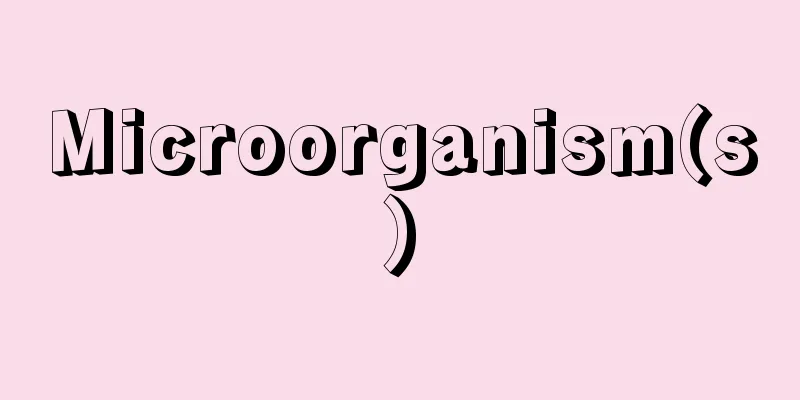Microorganism(s)

|
Generally speaking, microorganisms are a collective term for microscopic organisms. In other words, it is a general term for organisms that are so tiny that they cannot be clearly identified with the naked eye, and is not a purely biological classification. Although it is difficult to give a strict definition of this "individual," it is appropriate to think of it as the basic unit that carries out life activities. The range of organisms that are considered to be microorganisms is taxonomically broad, and the range varies depending on the scholar. However, in the broad sense of the term, microorganisms include the following eukaryotes and prokaryotes: protozoa, some microscopic animals of metazoa, unicellular algae (including phytoplankton), eukaryotic fungi (myxomycetes, molds, yeasts, mushrooms), and prokaryotes such as blue-green algae, bacteria including actinomycetes, and rickettsia and chlamydia. In addition, whether mushrooms and viruses should be considered as microorganisms is sometimes a subject of debate. In the case of mushrooms, the reason they are not considered microorganisms is that their fruiting bodies are large, and the reason they are considered microorganisms is that their hyphae, the basic unit of life, are microscopically tiny, just like the hyphae of molds. In the case of viruses, the question goes back to the essential question of whether to consider viruses as obligately parasitic structures or as living organisms that perform living activities, and the solution to this question remains to be seen (note that viruses are sometimes called supermicroorganisms because they are tiny under an electron microscope). [Masami Soneda and Hironori Terakawa] Microorganisms and MicroscopesThe discovery of microorganisms began with the invention of the microscope, and improvements to its structure have allowed many more microorganisms to be discovered and identified. The microscope invented by the Dutchman Leeuwenhoek in the early 17th century was a simple microscope with only one lens, but compound microscopes combining an eyepiece and an objective lens were soon developed, which dramatically improved the magnification. Today, in addition to optical microscopes like these, electron microscopes have been invented and have been developed from transmission types to scanning types, and improvements have been made to them, allowing not only to increase the effective magnification, but also to obtain high resolution and three-dimensional images. [Masami Soneda and Hironori Terakawa] The role of microorganisms in ecosystemsThere are three types of microorganisms: producers, consumers, and decomposers (reducers). Even in the hydrosphere and geosphere, which appear to be stationary at first glance, marine microbial communities, freshwater microbial communities, and soil microbial communities are made up, and material circulation is carried out by the actions of the three aforementioned groups. Of the three, fungi (including bacteria in this case) play an important role as decomposers and reducers. These are biodecomposers and corpse decomposers. In addition, fungi play an important role in the intestines of animals and in the rhizosphere of plants, helping animals and plants absorb nutrients. [Masami Soneda and Hironori Terakawa] Microorganisms in ApplicationsMicroorganisms that are dealt with in agriculture include plant pathogenic microorganisms, fermenting microorganisms, putrefactive microorganisms, edible microorganisms, and medicinal microorganisms. In medicine, there are pathogenic microorganisms and food poisoning microorganisms. From this perspective, we can see how close the relationship is between microorganisms and humans. In particular, pathogenic microorganisms are divided into obligate parasitic ones that reproduce only inside the host (the organism they are parasitic on) and facultative parasitic ones that sometimes parasitize and sometimes live alone. Also, fermenting microorganisms and putrefactive microorganisms are not essentially different in the sense that they are microorganisms that break down substances. In fact, fermentation and putrefactive microorganisms occur by the same type of microorganism. In other words, fermenting microorganisms are microorganisms that cause decomposition in a purposeful way from the human perspective, and putrefactive microorganisms are microorganisms that cause decomposition that is undesirable from the human perspective. Edible microorganisms and medicinal microorganisms are microorganisms that accumulate and retain trace elements such as proteins and vitamins in the body, and humans use them according to their own purposes. Examples include yeast and Chlorella (green algae). However, microorganisms (fungi) that synthesize antibiotics, hormones, amino acids, and other organic acids often produce these substances outside the bacterial cell, and are therefore considered fermenting microorganisms. Compared to other organisms, microorganisms have a short life cycle and are relatively easy to control artificially, so they are used as experimental materials in genetic, physiological, and biochemical research, and are useful in elucidating various basic biological phenomena. Furthermore, with the exception of obligately parasitic microorganisms, they can be isolated and cultured in pure form in test tubes. In the second half of the 19th century, a pure culture of bacteria was first performed by Koch of Germany. This marked the beginning of the application of this culture method to other microorganisms. The development of such culture techniques not only infinitely expanded the possibilities for using microorganisms, but also became the driving force behind the development of microbiology as a form of basic biology. [Masami Soneda and Hironori Terakawa] "Microorganisms and Their Uses" edited by Ogata Yasuya (1997, Corona Publishing)" ▽ "Molds and Yeasts: Microorganisms in Everyday Life" edited by Ozaki Michio and Tsubaki Keisuke (1998, Yasaka Shobo)" ▽ "Exploring Microorganisms" by Hattori Tsutomu (1998, Shincho Sensho)" ▽ "History of Microbiology 1 and 2 by Raymond W. Beck, supervised translation by Shimada Jingoro and Nakajima Hideki (2004, Asakura Publishing)" ▽ "Environmental Microbiology of the Aquatic Sphere" by Maeda Masatada (2005, Kodansha)" ▽ "Microbiology" edited by Hayashi Hideo, with Kadono Takeshi, Tomochika Kenichi, Hayashi Machiko, Hirano Naomi, Matsui Tokumitsu, and Mura Seiji (2005, Kenpakusha Publishing)" [Reference] |Source: Shogakukan Encyclopedia Nipponica About Encyclopedia Nipponica Information | Legend |
|
一般的には、顕微鏡的微小生物を総称して微生物という。つまり、個体が微小で、肉眼では明瞭(めいりょう)に識別できない生物に対する一般用語であって、純生物学的な区分ではない。この「個体」の厳密な定義はむずかしいが、生活活動を営む基本単位と考えるのが妥当である。 微生物として取り扱われる範囲は、分類学的に広い範囲にわたっているし、学者によってもその範囲は異なる。しかし、広義に微生物という場合には、次のような真核生物、原核生物が含まれる。すなわち、原生動物、後生動物の一部の微小動物、単細胞性の藻類(植物性プランクトンを含む)、真核菌類(変形菌類、カビ、酵母、キノコ)などの真核生物と、藍藻(らんそう)、放線菌を含む細菌類、リケッチアやクラミジアなどの原核生物である。また、キノコとウイルスを微生物として取り扱うかどうかが論議の対象となることがある。キノコの場合、微生物としない理由は、その子実体が大きいことであり、微生物とする理由は、生活基本単位である菌糸が、カビの菌糸と同様に顕微鏡的に微小なことである。ウイルスにおいては、ウイルスを絶対寄生性の構造体と考えるか、生活活動を行う生物として考えるかという本質的な問題にさかのぼるのであって、その解決は将来に残されている(なお、ウイルスは電子顕微鏡的に微小であるため、超微生物といわれることもある)。 [曽根田正己・寺川博典] 微生物と顕微鏡微生物の発見は顕微鏡が発明されてから始まったものであり、その構造の改良によって、さらに多くの微生物が発見され、確認されてきた。17世紀の初めにオランダのレーウェンフックによって発明された顕微鏡は、レンズが一つだけの単式顕微鏡であったが、やがて接眼レンズと対物レンズを組み合わせた複式顕微鏡が登場し、これによって拡大率は飛躍的に向上した。現在では、このような光学顕微鏡だけでなく、電子顕微鏡が発明されて透過型から走査型へと開発が進み、改良が加えられ、有効拡大率の向上だけではなく、高い解像率や立体像が得られるようになった。 [曽根田正己・寺川博典] 生態系のなかでの微生物の役割微生物には生産者、消費者、分解還元者(還元者)の三者がある。一見、静止しているようにみえる水圏や地圏の中においても、海洋微生物群、淡水微生物群、土壌微生物群が構成され、それぞれ前出の三者の働きによって物質循環が行われている。三者のうち、分解還元者として重要な働きをしている微生物は、菌類(この場合は細菌を含む)である。これらは生体分解還元者、死体分解還元者である。このほか、菌類は動物の腸管内や植物の根圏において、動物・植物が養分を吸収するのに重要な役割を果たしている。 [曽根田正己・寺川博典] 応用面での微生物農学のなかで取り扱われる微生物には、植物病原微生物、発酵微生物、腐敗微生物、食用微生物、薬用微生物がある。また、医学のなかでは、病原微生物や食中毒微生物がある。このようにみると、微生物と人間との関係がいかに密接であるかがわかる。とくに、病原微生物のなかには、宿主(しゅくしゅ)(寄生対象となる生物)の生体内でのみ繁殖する絶対寄生性のものと、あるときは寄生し、あるときは単独で生活を営む条件的寄生性のものとが区別される。また、発酵微生物と腐敗微生物とは、物質分解を行う微生物という意味からは、本質的には異なるものとはいえない。事実、同種の微生物によって発酵もおこるし、腐敗もおこる。いわば、人間からみて合目的的に分解をおこす微生物が発酵微生物であり、人間にとって不本意な分解をおこす微生物が腐敗微生物であるといえる。食用微生物、薬用微生物とは、タンパク質、ビタミンなどの微量成分を体内に蓄積して保持する微生物であり、人間はそれぞれの目的に従って利用している。酵母やクロレラ(緑藻類)などがこの例である。しかし、抗生物質、ホルモン、アミノ酸その他の有機酸などを合成する微生物(菌類)は、それらを菌体外につくることが多いため、発酵微生物として取り扱われる。 微生物は他の生物に比して、生活環が短いうえに人為的管理が比較的簡単であるため、遺伝学的研究や生理・生化学的研究の実験材料として使われ、基礎生物学的な諸現象の解明に役だっている。また、微生物は、絶対寄生性のものを除いて、試験管内で純粋分離培養することができる。19世紀の後半、ドイツのコッホによって初めて細菌の純粋培養が行われた。これが端緒となって、他の微生物にもこの培養法は応用された。こうした培養技術の発展は、微生物利用の可能性を無限に広げたばかりではなく、基礎生物学としての微生物学の発展の原動力となった。 [曽根田正己・寺川博典] 『緒方靖哉編著『微生物とその利用』(1997・コロナ社)』▽『小崎道雄・椿啓介編著『カビと酵母――生活の中の微生物』(1998・八坂書房)』▽『服部勉著『微生物を探る』(1998・新潮選書)』▽『レイモンド・W・ベック著、嶋田甚五郎・中島秀喜監訳『微生物学の歴史』1、2(2004・朝倉書店)』▽『前田昌調著『水圏の環境微生物学』(2005・講談社)』▽『林英生編著、角野猛・友近健一・林真知子・平野直美・松井徳光・村清司著『微生物学』(2005・建帛社)』 [参照項目] |出典 小学館 日本大百科全書(ニッポニカ)日本大百科全書(ニッポニカ)について 情報 | 凡例 |
<<: Microbial protein (microbial protein)
Recommend
Temporary demand - Kariju
...In this case, there are two methods: pure shor...
Stalinsk
...It lies on both banks of the Tomi River, a tri...
Greening work - Ryokkako
This refers to a revegetation technique or method ...
racing multihull
…Mainly for racing. (3) Racing multihull A multih...
Boundary Friction
Friction that occurs when the contact surfaces of ...
Eneide - Eneide
…He was from Verdeke near Maastricht (now part of...
Kanze Hideo - Kanze
Born October 4, 1927 in Tokyo, Japan [Died] June 8...
Subjective probability
Probability that evaluates the degree of uncertain...
Hippokrēnē (English spelling) Hippokrene
...Later, he became the horse of the hero Bellero...
Iwai Rebellion
The rebellion of Tsukushi no Kimi (Kuni no Miyats...
Congenital rubella syndrome - Sentensei fuushinshoukougun (English spelling) Congenital RBella syndrome
What is the disease? When a pregnant woman who is...
Old Sand Dunes
...Coastal sand dunes formed in the Holocene are ...
Moro tribe - Moro (English spelling)
A general term for Muslims living in the Philippin...
Red Kite (Flying Fish) - Red Kite
...In Miyazaki Prefecture, this species is called...
Tuul ghol (English spelling)
A river that flows through the northern part of th...









